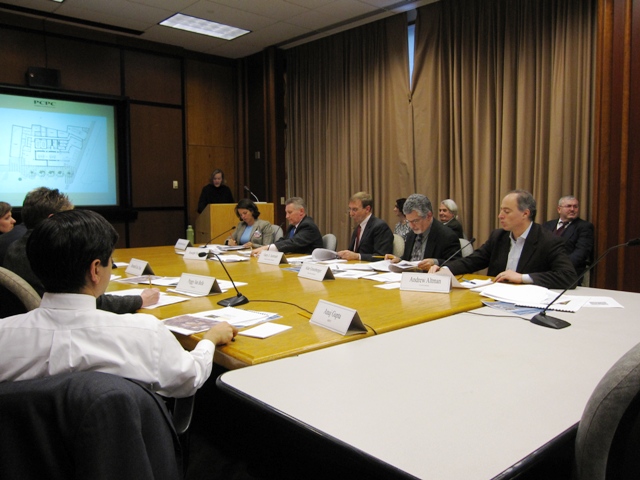Boston accent for Design Review?

Feb. 2
By Thomas J. Walsh
For PlanPhilly
The concept of a Design Review Committee for the Philadelphia City Planning Commission has been sitting quietly on the back pages of the Delaware Valley Regional Planning Commission’s Web site for more than a year now.
See 2007 presentation
Published in November 2007 and funded by the William Penn Foundation, the 90-plus page DVRPC document, “Promoting Civic Design Excellence In Philadelphia,” reads like a re-cap of events from the past year in Philadelphia’s planning and design world, while laying out a framework of the year or two to come.
Among the recommendations in the study for then-Mayor-elect Michael Nutter that have come to pass since he took office include the appointment of a deputy mayor for planning (the multi-fedora-donning Andrew Altman, who also heads up the Commerce Department and the new Delaware River Waterfront Corp.); the creation or revamping of the departments of transportation, sustainability and arts and culture; and a vocal and enforceable re-empowering of the Planning Commission.
“The first step in promoting civic design excellence is having a leadership that understands how critical civic design is to the success and livability of the great cities of America,” the report says. “The next step is having that leadership communicate this value to every member of City government, to the business community, and to the people of the city.”
The authors are the DVRPC’s Gregory Heller, a planning and design analyst, and Karin Morris, manager of the agency’s Office of Smart Growth (with Executive Director Barry Seymour and Smart Growth intern Josiah Neiderbach). They write that the report was based on months of research on the “functions, processes, and stakeholders involved in design, planning, and development in Philadelphia, as well as best practices and precedent in other cities.” It drew heavily from dozens of personal interviews in these other cities – “governmental contacts, design experts, and directors of design nonprofits and civic design centers.”
Interviewees in Philadelphia, however, are not named. This is “in order to protect individuals whose views may be controversial. Philadelphia interviews included governmental contacts from various departments, design and development consultants, leaders of design-based nonprofits and community development corporations (CDCs),
developers, architects, planners, and funders.”
The committee
The Design Review Committee would be a seven-member panel made up of design professionals of different disciplines, reporting directly to the Planning Commission. The commission says these kinds of review happened regularly within community groups on an ad hoc basis, but a committee dedicated to be a clearinghouse for the process would be more organized, transparent and accountable. A intention is to create “a public forum where developers and citizens can discuss projects before they are subject to regulatory action and where principles of design excellence, especially with regard to impact on the public realm, are articulated.”
The Planning Commission sent out draft recommendations to establish the committee on Jan. 19, and asked that interested parties respond with comments, questions and recommendations by Feb. 9. That date may be extended after some developers and members of active civic associations objected to what they deemed an inappropriately tight deadline.
Along with flaws in the existing zoning code (presumably being addressed by the ongoing overhaul of that code by the Zoning Code Commission), the DVRPC authors says there are “too few venues for community input, a permitting process that favors informal deal making, a lack of coordinated community investment, and numerous agencies that build projects without oversight or coordination.
“As a result, public and private projects emerge with inconsistent attention to design. Projects can be constructed without ever consulting the City Planning Commission. Developers can get projects of sub-par design approved and built. Neighborhoods are left on their own to raise funds and support for planning and local investment.”
“Philadelphia’s Art Commission performs design review for publicly funded structures, but Philadelphia does not have design review for most private development,” the report says in its introductory pages. “Design review of private development is utilized in cities across the U.S., including Atlanta, Baltimore, Boston, Nashville, Pittsburgh, Portland, and Seattle.”
Sample approaches for design guidelines are included from those cities and from Tampa, Austin and Los Angeles. “Model organizations” cited are the Municipal Art Society of New York, the Nashville Civic Design Center and the Community Design Center of Pittsburgh.
The Hub model
It is Boston’s flavor of design review, however, wound-up tightly with the Boston Zoning Code, that seems to be having the most influence on ideas behind what the Design Review Committee in Philadelphia will look like. Heller, along with Planning Commission Executive Director Alan Greenberger and others, pointed to that city’s “A Citizen’s Guide to Development Review” as a user-friendly way to envision a workable committee in Philadelphia, combined with relevant wisdom and methods from other cities’ committees.
Developers are hoping the Planning Commission goes slow with what they fear could be another large hurdle in the approvals process for private building.
“Boston has a 106-page ordinance [on their design review process],” Philadelphia developer and city planning veteran Craig Schelter said last week. “That said to me that while you may have it, it takes a long time to figure out what to say, what the exemptions are, and how you justify it.”
Indeed, the Boston Redevelopment Authority (that city’s planning and economic development agency) breaks down design review into large projects, small projects, projects within “Planned Development Areas” and development for hospitals and colleges within “Institutional Master Plan” areas.
But George Claflen, a Philadelphia design expert and architect who was on the advisory committee to the DVRPC for its November 2007 report, says Boston’s Civic Design Commission is a much more complex animal than what is being proposed here.
“The strategy here is to have people on the committee who are highly qualified reflect on the design in terms of the public space,” said Claflen, who did say that some of Boston’s zoning guidelines were incorporated into the current draft recommendations.
Claflen sits on the 18-member steering committee of the city’s Design Advocacy Group (Schelter, Greenberger and Heller are also members, in addition to Harris Steinberg, executive director of PennPraxis, the parent organization of PlanPhilly). Greenberger will be addressing DAG this week, on Thursday evening (Feb. 5) about the ongoing process.
The role of the Design Review Committee “must be earned” by garnering the respect of all involved in the process, Claflen said, and “not granted by fiat.”
“For developers; this is no way to bully them, or restrict their projects. It’s a new level of sophistication and a representation of the public interest. The neighborhoods should take some comfort that if this is implemented, you’re going to have a high quality discussion on whatever is being proposed.”
Contact the reporter at www.ThomasJWalsh.info.
ON THE WEB:
DVRPC’s “Promoting Civic Design Excellence In Philadelphia”: http://www.dvrpc.org/asp/pubs/reports/07049.pdf
Boston’s “A Citizen’s Guide to Development Review”: http://www.bostonredevelopmentauthority.org/pdf/documents/A%20Citizens%20Guide%20to%20Article%2080.pdf
PlanPhilly, “Design review? ‘Not so fast’” (Jan. 27, 2009): http://www.planphilly.com/node/6918
Design Advocacy Group of Philadelphia: http://www.designadvocacy.org/
WHYY is your source for fact-based, in-depth journalism and information. As a nonprofit organization, we rely on financial support from readers like you. Please give today.






